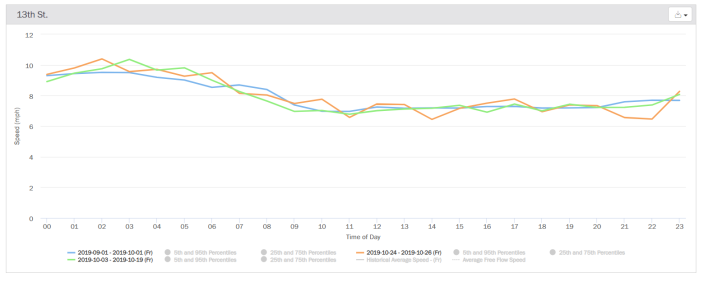Papa, don't preach.
Another set of data confirms earlier findings that residential side streets adjacent to the 14th Street "busway" are not becoming gridlocked by traffic, countering a specious, anecdotal tweet by radio reporter Juliet Papa, who launched a missive last Friday during normal rush-hour traffic.
"Traffic backed up for blocks on 13th St because no cars on 14th," she tweeted. "Local resident sees me snapping photo and says 'help us.' There’s more traffic and noise here now.”
Data says she's wrong.
New analysis by INRIX, an independent traffic consultant frequently hired by the DOT to review its work, declared that there may have been an increase in total cars on 13th Street, "there has been no actual decrease in travel times," the company said in a brief update obtained by Streetsblog.
"The higher number of vehicles that are making it look like congestion has worsened when in reality trips are not taking measurably longer than they used to.”
The night in question "looks like just normal Friday rush hour," the company added.

The chart above shows travel speeds along 13th Street. The orange line represents last Friday, when Papa experienced her meltdown. The blue line is the average of the four Fridays immediately preceding the busway’s opening. The green line is the average performance for the three other Fridays since the busway’s opening. As you can see, there hasn't been much of a change since the busway launched on Oct. 3.
The latest data match traffic findings previously obtained by Streetsblog. That report, from about two weeks into the busway experiment, showed that travel times for drivers were basically the same. The worst spot turned out to be 16th Street, where drivers making the run between Ninth Avenue and Union Square West, were delayed by just 23 seconds, thanks to a tiny decrease in traffic speed from 7.3 miles per hour to 6.9 miles per hour.
In the end, Papa's tweet appears to show a normal line of cars stopped at a red light.
Traffic backed up for blocks on 13th St because no cars on 14th. Local resident sees me snapping photo and says “ help us.” There’s more traffic and noise here now.” @NYCSpeakerCoJo @NYC_DOT @1010WINS pic.twitter.com/zzsasaglPf
— Juliet Papa (@winsjuliet) October 25, 2019






